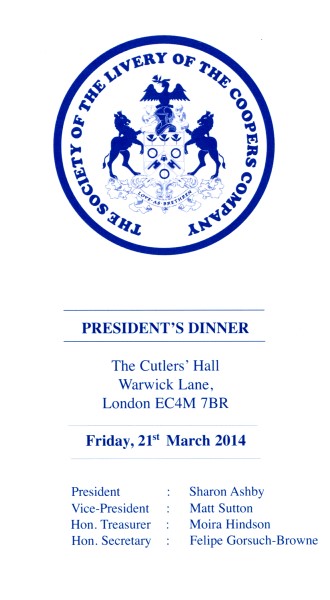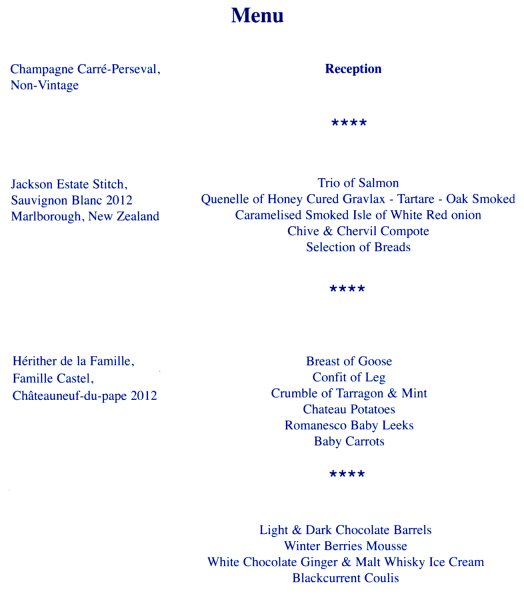
Tel: 020 7620 1818 email: cookandbutler@btconnect.com
The Worshipful Company of Coopers and
The Society of The Livery of The Coopers' Company
www.coopers-hall.co.uk
President's
Dinner
March 2014, Cutlers' Hall, London


![]()
The Worshipful Company of Coopers and
The Society of The Livery of The Coopers' Company
The Company is one of the ancient craft guilds of the
City of London, first mentioned in City records in 1298, and receiving a
Royal Charter in 1501. It was responsible for the control of the trade
of cask making and their usage, the standard of workmanship, and the
welfare of its members and their families, for the first several hundred
years of its existence.
Casks in their various sizes were the standard container of general
trade and were used not just for liquids, such as beer and spirits, but
also for food, such as salt beef, fruit and vegetables, as well as being
used to store gunpowder. Also it may be remembered that the body of
Admiral Lord Nelson was conveyed home in a cask of French brandy,
following his death at Trafalgar.
In more modern times, the art and craft of making casks and other wooden
containers by hand in Britain has gradually declined. There are no
longer any working coopers in the City of London. Although there are
still working coopers in other, mainly wine-producing, parts of the
world, the links with the craft in this country have become more
tenuous. As a result, the Company's main aims are now its work in the
fields of charity and education, its history and museum, and the part
the Company plays in the life of the City. The Company is controlled by
a Master and a Court of Assistants, assisted by the Clerk and
secretariat.
The Company's activities would not be possible today without active
Liverymen and Freemen supporting the Company in perfect harmony.
However, this was not always the case.
Following rumblings of dissatisfaction in the 18th Century, there was
open revolt in 1823 after heavy fines and fees had been levied on
members of the Company. This revolt resulted in the Livery having its
own choice as Warden appointed, rather than a Court nominee, and flushed
with that success, the Society was formed in 1827 as an independent
representative voice of the Livery. Whilst the Society and the Court
were at loggerheads throughout much of the 19th Century, peace
eventually broke out, and from then onwards the Society increasingly ran
the social side of the Company, as an organisation within an
organisation. It is also a conduit for the views of the Livery direct to
the Court through the elected Under and Upper Wardens, who have
traditionally been the President and Immediate Past President of the
Society.
![]()